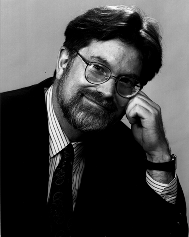 and professor of physics at the University of California at Berkeley, is the
23rd LBL recipient of the award. Inaugurated in 1959, the Lawrence Award
honors the memory of LBL founder Ernest Orlando Lawrence. It includes a gold
medal and $10,000.
and professor of physics at the University of California at Berkeley, is the
23rd LBL recipient of the award. Inaugurated in 1959, the Lawrence Award
honors the memory of LBL founder Ernest Orlando Lawrence. It includes a gold
medal and $10,000.BERKELEY -- George Smoot, who discovered the ancient seeds that grew into the galaxies and superclusters of galaxies that populate today's universe, has been named one of eight winners of the 1994 E.O. Lawrence Award by Secretary of Energy Hazel O'Leary.
Smoot, an astrophysicist in Lawrence Berkeley Laboratory's Physics Division
 and professor of physics at the University of California at Berkeley, is the
23rd LBL recipient of the award. Inaugurated in 1959, the Lawrence Award
honors the memory of LBL founder Ernest Orlando Lawrence. It includes a gold
medal and $10,000.
and professor of physics at the University of California at Berkeley, is the
23rd LBL recipient of the award. Inaugurated in 1959, the Lawrence Award
honors the memory of LBL founder Ernest Orlando Lawrence. It includes a gold
medal and $10,000.
Said Smoot, "Because Lawrence was a remarkable experimental physicist, this is a particularly great honor. This work would not have been possible without the tradition of excellence established by Lawrence, the support of the lab leadership and in particular, Bob Cahn (Physics Division Director)."
Smoot won in the category of physics for his work on the cosmic microwave background, the faint afterglow left over from the Big Bang. He was cited "for his leadership in the remarkably accurate measurements of the variations in the cosmic microwave background radiation, thus clarifying our understanding of the early history of the universe, the distribution of dark matter, and the formation of stars and galaxies."
The cosmic background radiation was first detected in 1964 by Nobel Prize winners Arno Penzias and Robert Wilson. While doing satellite communications experiments, the pair encountered interference, a hiss that was remarkably uniform no matter which direction in the sky their antenna was pointed. This microwave noise -- it had a temperature of 2.7 degrees kelvin -- turned out to be the relic radiant heat from the primeval fireball.
From that date, researchers began looking for tiny fluctuations in this radiation. If these irregularities existed, then over the billions of years since the Big Bang, gravity would have magnified them into the stars and galaxies we observe today. If they did not exist, then the Big Bang theory of the origin of our universe was off-base.
In 1976, Smoot was a key member of the team that discovered what they called "the dipole anisotropy" of the cosmic microwave background. This established that our Milky Way galaxy is not only expanding along with the remainder of the universe but, surprisingly, moving at its own peculiar velocity at over a million miles per hour.
According to the Lawrence Award citation, "Knowledge of this velocity has allowed cosmologists to make one of the best estimates of the mass density of the universe. This estimate makes a very strong case for the existence of more matter in the universe than can be accounted for by ordinary matter, helping to make the case for unusual forms of dark matter."
Two years before that, Smoot had submitted a satellite proposal to NASA to measure and map the cosmic microwave background. The satellite was launched in 1989, and in April 1992, Smoot's team announced they had found what had evaded scientists for 28 years.
The team displayed images that mapped the unevenness in the microwave sky. The sky maps record a time about 300,000 years after the Big Bang, the earliest pictures we have of the universe. They show regions that vary in temperature and density by one part in 100,000. These irregular regions represent the seeds of creation.
Since then, the findings have been confirmed by several groups including a December 1992 confirmation by an MIT and Goddard Space Flight Center experimental team.
Smoot, whose quest consumed 20 years, was born in Yukon, Florida in 1945. He attended M.I.T., earning a B.S. in mathematics and physics and a Ph.D. in physics. In 1971, he came to LBL, joining the team of Nobel Prize winner Luis Alvarez, and began a career in cosmology.
Four of the eight winners of the 1994 Lawrence Awards are from national laboratories managed by the University of California. Winners of the award, which will be presented in Washington, D.C. at a date to be announced, are Michael Campbell and John Lindl from Lawrence Livermore National Laboratory (National Security); Gregory Kubas from Los Alamos National Laboratory (Chemistry); Edward Larsen from the University of Michigan (Nuclear Technology); Gerald Ludtka from Oak Ridge National Laboratory (Materials Research); John Till from Radiological Assessments Corp. (Environmental Science and Technology); and John Boice from the National Cancer Institute (Life Sciences).
Energy Secretary O'Leary said, "The results of these winners' work clearly demonstrate the contributions that basic and applied research make to our Nation -- to our economy, to our health and safety, and to our understanding of the universe around us."
LBL is a national laboratory that conducts unclassified scientific research for the U.S. Department of Energy. It is located in Berkeley, California, and is managed by the University of California.